After drawing inspiration from Saul Bass’ Exodus, I then created my humument cover based on its color scheme. I also decided to do my own rendition of the “flames” due to fire being a running theme throughout the piece.
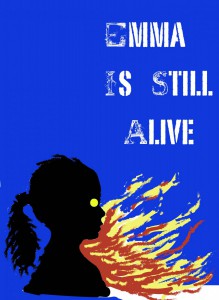
After drawing inspiration from Saul Bass’ Exodus, I then created my humument cover based on its color scheme. I also decided to do my own rendition of the “flames” due to fire being a running theme throughout the piece.

After our trip to Cooper Hewitt, I decided to choose a piece of art by Saul Bass called Exodus. This piece was created in 1961, and was poster designed for Otter Preminger’s film Exodus. I chose this particular piece because i thought it would be an excellent color scheme for my humument, and it also featured fire, which is already a pretty important part of my piece. I then created its color pallet, and used it as a base for my own cover art.
For this project i chose as piece called “THE GREAT MOON HOAX OF 1835” Posted on October 25, 2015. I chose this piece of work because it represents what my theme of my book is, the theme of my book is observation and the title “Essence” comes from the original title of the book which was “silences” by Tillie Olsen. I also liked the colors that were used in the work that i used and i think it goes great with the aspect i was trying to convey.
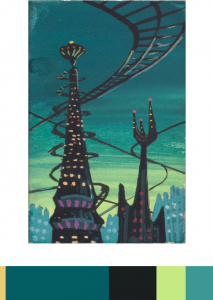

The reason I chose this image(CONCEPT ART, MONSTER CITY, MONSTERS, INC., 2001) from Cooper Hewitt is that I feel like it really match the themes of my humument work. The themes of my humument work are dreams and loneliness. The picture is basically bule and black. That gives me a stronge feelling of derams and loneliness.
I chose this image (DATA VISUALIZATION, FLIGHT PATTERNS, 2005–08) to reference in my Humument book cover because it is a juxtaposition of my books them. The original theme is about a boy becoming of age, and the new theme is mysterious. This image is mysterious because of all the negative space with the colorful spirals in the center.
Source Link
Time Spent – about 2 hours.
I picked this from the design gallery at the Cooper Hewitt, Smithsonian Design Museum; Book cover, Amerika, 1947 design by Alvin Lustig. The explanation of why Lustig made this cover is said from the the didactic from the web site that states, “…employ abstracted iconography and simple typography and lettering to create emotionally compelling representations of a book’s themes.” I picked this cover, because it was simple. As in, it had simple colors compared to others. Others tend to have multiple colors that it didn’t identify it, for my connection in the theme. Since my dominant color is dark blue, the use of shade in the ballerina drop shadow was difficult. However, if you see it closely it is actually a more dark shade of blue. I also used tint in the title of my book and also a shade for my name at the bottom. For over all phase 3, I spend about two hours. I didn’t use any tin or shade at the back cover, since I wanted the reader to actually see the text. I used Photoshop to complete this phase. Link to Cooper Hewitt Research: Here
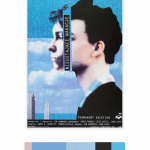
For this phase of the project, we visit the Cooper Hewitt museum as a class trip. Here we explored many fields of art from graphics, sculptures, textiles, motion graphics, architecture, and so on. We were to use an inspiring piece of art found in the museum that also fit our selected theme for our humument books. My book in specific talks about a journey and I am juxtaposing that with the theme of memories. There is a relation but big difference between a journey and a memory. While on journey, a person’s experience is physical and fruitful. A memory on the other hand is a mental experience which we feel emotionally not physically. I also chose to articulate various memories of people from different walks of life to emphasize the differential between people. My book on the other hand shows how people can sometimes be all connected. I chose this as reference for my color inventory because when I first looked at it my mind suddenly became clear and peaceful. The peacefulness perceived from the blue allowed my mind to relax and reminisce. I’ve learned different shades, tints of blue can emit different emotions and this blue specifically gives a tranquil, relaxed state of mind. Although it’s peaceful the feeling of assurance is also provided. This part took me about 2 hours 20 mins.
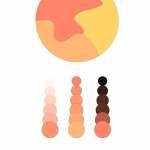
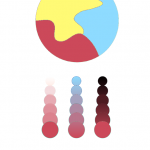
The Analagous color pallete on top displays Analagous colors. These are colors that lie adjent to one another on the color wheel. For example you want the color green. You’ll then chose one color after and before green which are green blue and yellow green. That leaves you with Green, green blue, and yellow green. Together those colors will work harmoniously and that is a strategy in choosing colors. For My analagous pallete I decided to stick with muted warm colors. To be more specific I have a muted red-orange, orange and yellow-orange mashup in my composition. Under my composition I show an example of tint on the left, a two color gradient in the middle and shade on the right.
For split complementray colors you take one color and use the two colors adjacent to its compliment. An example is Violet, then find it’s compliment (yellow). The colors that come before and after yellow are orange and green. That means violet, orange, and green work harmoniously as a split complimentary color pallete. This composition contains muted colors aswell. Colors are muted with white leaving tinted red violet, blue and yellow. Below my composition, you see three examples, the left showing shade, the right showing tint and the middle showing a two color gradient. I did both compositions using Adobe Color CC Program. In total I spent around 2 hours.
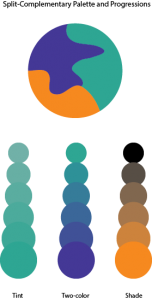
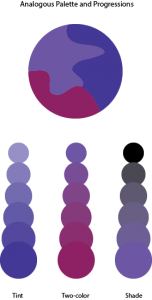
In this phase I learned about more behind color by learning about color harmony. When certain colors are together it feels as though it’s very pleasing. Colors can be harmonious in terms of shading, tints, compliments, tone and gradient. For the split-complementary palette, I had to choose one main color then choose two colors that is on either side of its complement. I chose orange as the main color while blue-green and blue-violet are the other two colors. For the analogous palette, I had to chose colors that were adjacent to each other on the color wheel. In this case I picked red-violet, blue-violet and violet. It took me 2 hours to complete this phase.